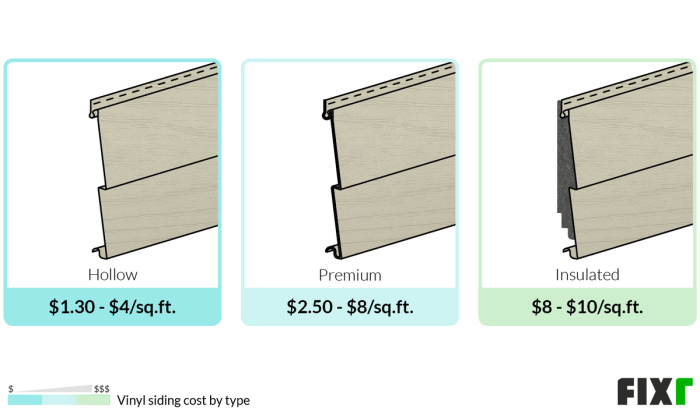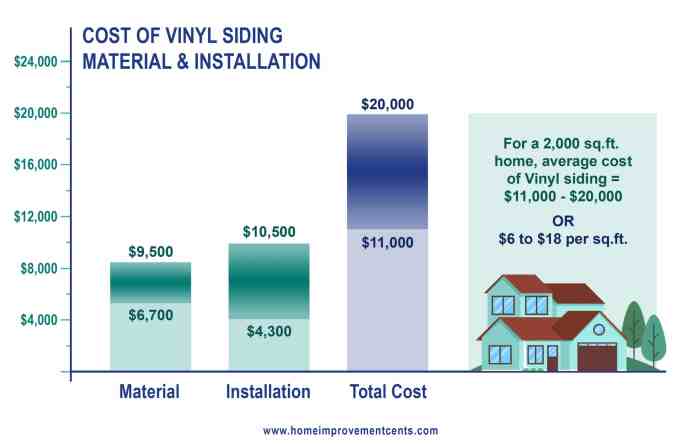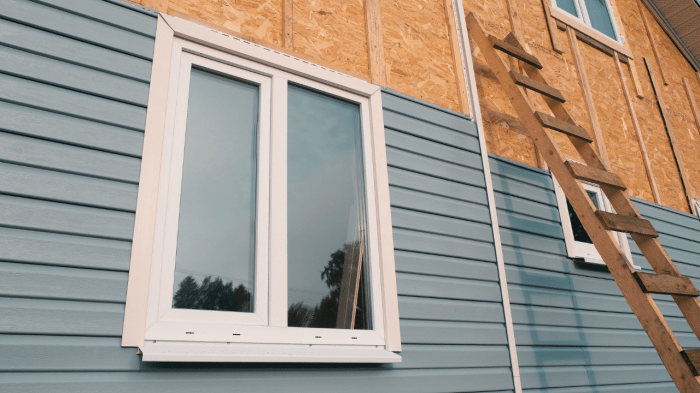Vinyl siding cost per square foot is a crucial factor for homeowners planning exterior renovations. Understanding this cost, however, goes beyond a simple price tag; it delves into the interplay of material quality, installation complexities, regional variations, and even the aesthetic choices you make. This guide unravels the intricacies of vinyl siding costs, providing a comprehensive overview to empower you with informed decisions.
From the initial price per square foot of the siding itself to the hidden costs of permits and labor, we’ll explore every aspect. We’ll dissect the differences between basic, mid-range, and premium vinyl siding, examine the impact of your home’s size and design on installation costs, and even offer visual examples to inspire your project. By the end, you’ll have a clear understanding of the total cost you can expect and how to make the most of your budget.
Average Vinyl Siding Costs
Vinyl siding offers a durable and relatively low-maintenance exterior cladding option for homes. Understanding the cost involved is crucial for budgeting a home renovation or new construction project. This section details average vinyl siding costs, influencing factors, and variations based on style and quality.
The price of vinyl siding installation varies considerably depending on several key factors. While a simple estimate might seem straightforward, a deeper dive reveals a more complex picture.
Vinyl Siding Cost Breakdown by Quality
The cost of vinyl siding significantly depends on the quality of the material. Basic options offer affordability, while premium choices boast enhanced durability and aesthetic appeal. The following table provides a general cost range per square foot for different quality levels. Keep in mind that these are estimates, and actual costs may vary based on location and other factors.
| Quality | Price Range ($/sq ft) | Features | Considerations |
|---|---|---|---|
| Basic | $2.00 – $4.00 | Thinner material, limited color options, shorter warranties | Suitable for budget-conscious projects, may require more frequent replacement. |
| Mid-Range | $4.00 – $6.00 | Thicker material, wider color selection, longer warranties, improved durability | Offers a good balance between cost and quality. |
| Premium | $6.00 – $10.00+ | Thickest material, extensive color options, longest warranties, superior durability, often includes features like impact resistance and fade protection. | Ideal for long-term durability and enhanced curb appeal; represents a higher upfront investment. |
Factors Influencing Vinyl Siding Cost Per Square Foot
Several factors beyond material quality significantly impact the overall cost of vinyl siding installation. These factors can lead to considerable variation in the final price.
- Labor Costs: Labor costs vary regionally and are influenced by the contractor’s experience and demand. Highly skilled installers in high-demand areas may charge more.
- Regional Variations: Material costs and labor rates differ across geographical locations. Areas with high construction activity or limited supply may have higher costs.
- Material Choices: The type of vinyl siding chosen (e.g., style, color, thickness) directly affects the cost. Premium materials with specialized features will be more expensive.
- Project Complexity: Projects requiring extensive preparation, such as removing old siding, repairing underlying sheathing, or navigating complex architectural details, increase labor costs.
- Waste Factor: The amount of siding needed often exceeds the calculated square footage due to cuts and waste. Contractors may factor in a waste percentage into their estimates.
- Permits and Inspections: Depending on local regulations, permits and inspections may be required, adding to the overall project expense.
Cost Differences Based on Vinyl Siding Styles and Profiles
Vinyl siding comes in various styles and profiles, each influencing the final cost. Different profiles offer distinct aesthetic appearances and may require varying installation techniques.
For example, a simple clapboard profile is generally less expensive than more intricate styles like Dutch lap or shingle siding. The added complexity of installation for these more detailed profiles often translates to higher labor costs. The availability of certain styles and colors in a given region may also affect pricing. A highly sought-after style might command a premium compared to more common options.
Installation Costs: Vinyl Siding Cost Per Square Foot

Installing vinyl siding involves more than just nailing the panels to your house. A comprehensive understanding of the associated costs is crucial for accurate budgeting. This section breaks down the typical expenses involved in a professional vinyl siding installation.
The total cost of vinyl siding installation is significantly influenced by several factors. While the material cost per square foot is a key element, the labor costs often represent a substantial portion of the overall expense. Understanding these labor components is vital for making informed decisions about your project.
Cost Breakdown per Square Foot
The cost of installing vinyl siding typically ranges from $3 to $8 per square foot, but this can vary considerably. This price includes preparation, installation, and cleanup. The following breakdown illustrates the typical cost components:
- Preparation: This includes removing old siding, repairing damaged sheathing, and ensuring the house is properly prepared for the new siding. This phase might account for 10-20% of the total labor cost, depending on the existing condition of the exterior walls. For instance, if significant rot repair is required, this phase could significantly inflate costs.
- Installation: This is the core of the process, involving the actual installation of the vinyl siding panels, trim, and accessories. This typically constitutes the largest portion of the labor cost, around 60-70%. Skilled installers ensure proper overlapping and alignment for a professional finish.
- Cleanup: This includes removing debris, disposing of old materials, and leaving the work area clean and tidy. This often accounts for 10-15% of the total labor cost, although this can vary based on the scale of the project and the installer’s practices.
Factors Influencing Installation Costs
Several factors can significantly impact the final installation cost. These factors need careful consideration when planning a vinyl siding project.
- Complexity of the Project: Houses with intricate architectural details, multiple gables, dormers, or complex trim work will naturally require more time and labor, leading to higher costs. A simple ranch-style home will be cheaper to side than a Victorian-style house with numerous angles and projections.
- Size of the House: The square footage of the house directly correlates with the amount of material and labor needed. Larger houses obviously require more siding and more installation time, thus incurring higher costs.
- Installer’s Experience: Experienced and reputable installers often charge more per square foot, but their expertise ensures a higher quality installation and potentially fewer future problems. Inexperienced installers may offer lower rates, but this could lead to mistakes that necessitate costly repairs down the line.
Professional Installation vs. DIY
Choosing between professional installation and a DIY approach involves weighing costs, skills, and time commitment. The following table summarizes the key differences:
| Professional Installation | DIY Installation |
|---|---|
| Higher upfront cost | Lower upfront cost |
| Faster installation time | Longer installation time |
| Warranty on labor and materials (often) | No warranty on labor |
| Higher quality and professional finish | Potential for mistakes and subpar finish |
| Less physical labor and effort | Requires significant physical labor and skill |
| Example Cost: $3,000 – $8,000 for a 1,000 sq ft house | Example Cost: $1,000 – $3,000 for materials, plus significant time investment |
Material Costs
Understanding the material costs associated with vinyl siding installation is crucial for accurate budgeting. Several factors influence the final price, including the type of siding chosen, the quantity needed, and the cost of any additional materials required for a complete installation. This section breaks down the typical materials and their associated costs.
Vinyl Siding Panel Costs
The cost of vinyl siding panels is a significant portion of the overall project expense. Different manufacturers and styles offer varying price points, impacting the overall square footage cost. The following table provides estimated costs; actual prices may vary based on location, supplier, and specific product features.
| Material | Unit Cost ($/sq ft) | Quantity Needed (per 100 sq ft) | Total Estimated Cost |
|---|---|---|---|
| Standard Vinyl Siding Panels | $0.75 – $2.00 | 100 sq ft | $75 – $200 |
| Premium Vinyl Siding Panels (e.g., thicker, more durable) | $2.50 – $4.00 | 100 sq ft | $250 – $400 |
| Specialty Vinyl Siding Panels (e.g., shakes, shingles) | $3.00 – $6.00+ | 100 sq ft | $300 – $600+ |
Cost Differences Between Vinyl Siding Manufacturers and Brands
Vinyl siding manufacturers and brands vary significantly in terms of quality, durability, and price. Established brands often command higher prices due to their reputation for superior performance and warranties. For instance, CertainTeed and James Hardie are known for their high-quality products, resulting in a higher cost per square foot compared to lesser-known brands. However, the long-term value proposition of premium brands often justifies the initial higher investment due to extended lifespans and reduced maintenance needs. Conversely, budget-friendly options may offer lower upfront costs but potentially compromise on durability and longevity, leading to higher replacement costs in the long run. It is crucial to carefully weigh the initial investment against the long-term value and expected lifespan.
Comparison of Various Vinyl Siding Materials
Several types of vinyl siding offer diverse aesthetic and performance characteristics. The choice depends on budget, desired look, and climate conditions.
| Vinyl Siding Type | Durability | Aesthetics | Price Point ($/sq ft) |
|---|---|---|---|
| Standard Vinyl Siding | Moderate; susceptible to impact damage | Wide range of colors and styles | $0.75 – $2.00 |
| Double 4″ Vinyl Siding | Improved durability compared to standard | Classic look, versatile styles | $1.00 – $2.50 |
| Vinyl Shake and Shingle Siding | Similar durability to standard; prone to cracking | Natural wood appearance | $3.00 – $6.00+ |
| Insulated Vinyl Siding | Similar durability; improved insulation | Similar aesthetic options to standard siding | $2.00 – $4.00+ |
Additional Costs

Beyond the basic material and labor costs associated with vinyl siding installation, several additional expenses can significantly impact the overall project budget. Understanding these potential costs upfront is crucial for accurate budgeting and avoiding financial surprises. Failing to account for these can lead to project delays and cost overruns.
Several factors beyond the square footage can influence the final cost of your vinyl siding project. These additional expenses often go unnoticed until they arise, potentially derailing your budget. Careful planning and proactive communication with your contractor can help mitigate these risks.
Permitting and Inspections, Vinyl siding cost per square foot
Securing the necessary permits from your local municipality is a crucial step, often overlooked in initial cost estimations. Permitting fees vary widely depending on location, project scope, and the specific requirements of your local building codes. These fees typically cover the review of your project plans to ensure compliance with local regulations and safety standards. Furthermore, inspections throughout the installation process are usually required to ensure adherence to building codes, adding to the overall cost. Expect to budget for both the permit application itself and any subsequent inspection fees.
Demolition and Waste Removal
If your existing siding needs removal before the new vinyl siding can be installed, demolition costs will be added to the total project cost. This includes the labor required to carefully remove the old siding, dispose of the materials responsibly, and prepare the underlying structure for the new siding. Waste removal is another significant factor, as disposal fees for construction debris can vary based on volume and local regulations. Larger projects, or those involving the removal of hazardous materials like asbestos, will incur higher demolition and waste disposal costs.
Unexpected Costs During Installation
Unforeseen issues during installation are common in home renovation projects. These can range from discovering rotted wood requiring repairs before siding installation to encountering unexpected obstacles like difficult-to-remove trim or underlying structural problems. These unexpected issues can significantly inflate the project’s final cost if not properly accounted for. A detailed pre-installation inspection by a qualified contractor can help identify potential problems early, minimizing surprises and allowing for accurate cost adjustments.
Scenario: Total Cost Calculation for a 1500 sq ft House
Let’s consider a hypothetical 1500 sq ft house requiring new vinyl siding. Assume a material cost of $5 per square foot, installation cost of $3 per square foot, permitting fees of $500, demolition costs (including waste removal) of $1000, and an unexpected cost contingency of 10% to account for unforeseen repairs or issues.
- Material Cost: 1500 sq ft * $5/sq ft = $7500
- Installation Cost: 1500 sq ft * $3/sq ft = $4500
- Permitting Fees: $500
- Demolition & Waste Removal: $1000
- Contingency (10%): ($7500 + $4500 + $500 + $1000) * 0.10 = $1350
Total Estimated Cost: $7500 + $4500 + $500 + $1000 + $1350 = $14850
Visual Examples

Choosing the right vinyl siding can dramatically impact a home’s curb appeal and perceived value. The following examples illustrate how different siding styles, colors, and accents can transform a home’s exterior, influencing its overall aesthetic and estimated cost. These estimates are based on average labor and material costs in the US and should be considered approximations. Actual costs can vary based on location, project complexity, and contractor.
Example 1: Classic Colonial with Dutch Lap Siding
This example features a two-story colonial-style home clad in classic white Dutch lap vinyl siding. The clean lines of the Dutch lap create a timeless and elegant look. Dark brown trim around the windows, doors, and roofline provides a striking contrast, enhancing the architectural details. A subtle texture in the siding adds depth without being overly ornate. The estimated cost for this siding, including installation and trim, is approximately $6.50-$8.00 per square foot. This range reflects potential variations in trim complexity and labor costs. The white siding maintains a clean and bright appearance, increasing the home’s perceived value by contributing to a well-maintained and inviting exterior.
Example 2: Modern Farmhouse with Vertical Siding and Board and Batten Accents
This modern farmhouse showcases the versatility of vinyl siding. The main body of the house uses a light gray vertical siding, offering a contemporary feel. The vertical orientation adds a sleek, modern touch compared to the more traditional horizontal style. Board and batten accents are used strategically around the windows and on the gables, adding visual interest and breaking up the large expanses of siding. The dark gray board and batten creates a sharp contrast against the light gray, drawing the eye to the architectural features. The estimated cost for this combination, including installation and accents, is approximately $7.00-$9.00 per square foot, slightly higher due to the added complexity of the vertical installation and board and batten application. The color scheme contributes to a sophisticated and updated look, increasing the home’s perceived value by projecting a sense of modern style and careful design.
Example 3: Ranch Style with Shake-Style Vinyl Siding
This ranch-style home utilizes a textured shake-style vinyl siding in a warm, earthy brown tone. The shake texture mimics the look of natural wood shakes, providing a rustic and charming appeal without the high maintenance of real wood. White trim around the windows and doors complements the brown siding, creating a clean and inviting contrast. The estimated cost for this style, including installation, is approximately $6.00-$7.50 per square foot. The rustic charm and low-maintenance nature of this siding option contribute to a relaxed and comfortable feel, increasing the perceived value by presenting a home that is both visually appealing and easy to maintain. The earthy brown tone creates a sense of warmth and connection to nature, which can be highly desirable to potential buyers.
Ultimately, the cost of vinyl siding per square foot is a multifaceted equation. While the base material price provides a starting point, the true cost encompasses labor, material selection, project complexity, and unforeseen expenses. By carefully considering these factors and utilizing the information presented here, homeowners can effectively budget for their vinyl siding projects, ensuring a successful and aesthetically pleasing outcome that enhances their home’s curb appeal and value.
General Inquiries
What is the lifespan of vinyl siding?
With proper installation and maintenance, vinyl siding can last 20-50 years.
Can I install vinyl siding myself?
While DIY is possible, professional installation ensures longevity and warranty validity. The cost savings might be offset by potential mistakes.
Does vinyl siding increase home value?
Yes, generally. High-quality vinyl siding enhances curb appeal, increasing your home’s market value.
How often should I clean my vinyl siding?
Regular cleaning (once or twice a year) with water and a soft brush prevents dirt buildup and maintains its appearance.
What are the common warranty periods for vinyl siding?
Warranty periods vary by manufacturer but typically range from 10-50 years, covering defects in materials and workmanship.


